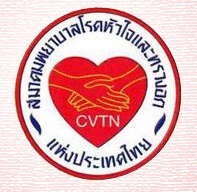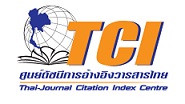ความสัมพันธ์ระหว่างปัจจัยพื้นฐาน ความรู้และพฤติกรรมของญาติผู้ดูแลในการดูแลผู้ป่วยโรคหลอดเลือดแดงที่ขาตีบตัน
คำสำคัญ:
ญาติผู้ดูแล, ปัจจัยพื้นฐาน, พฤติกรรมการดูแล, ความรู้, โรคหลอดเลือดแดงที่ขาตีบตันบทคัดย่อ
การวิจัยเชิงบรรยายครั้งนี้มีวัตถุประสงค์เพื่อศึกษาความสัมพันธ์ระหว่างปัจจัยพื้นฐานและความรู้ของญาติผู้ดูแลกับพฤติกรรมในการดูแลผู้ที่มีโรค PAOD ใช้กรอบแนวคิดความพร่องในการดูแลตนเองของโอเร็ม กลุ่มตัวอย่างเป็นญาติผู้ดูแลผู้ที่มีโรค PAOD จำนวน 60 ราย มารับบริการที่แผนกศัลยกรรม โรงพยาบาลมหาวิทยาลัย เก็บรวบรวมข้อมูลโดยใช้แบบสอบถาม 3 ชุด คือ 1) ข้อมูลส่วนบุคคล 2) ความรู้เรื่องโรค PAOD และ 3) พฤติกรรมการดูแลผู้ที่มีโรค PAOD วิเคราะห์ข้อมูลโดยใช้สถิติเชิงพรรณนา สถิติสหสัมพันธ์แบบเพียร์สัน (Pearson’s correlation) และสถิติสหสัมพันธ์แบบสเปียร์แมน (Spearman rank correlation coefficient)
ผลการศึกษาพบว่า ญาติผู้ดูแลส่วนใหญ่เป็นผู้หญิง อายุระหว่าง 30-72 ปี ส่วนใหญ่จบปริญญาตรี เกือบครึ่งเป็นความดันโลหิตสูง สำหรับผู้ป่วยส่วนใหญ่เป็นผู้ชาย อายุระหว่าง 60-95 ปี ความรู้ของญาติผู้ดูแลเกี่ยวกับโรค PAOD อยู่ในระดับน้อย พฤติกรรมการดูแลผู้ที่มีโรค PAOD อยู่ในระดับมาก ปัจจัยพื้นฐานของญาติผู้ดูแลไม่สัมพันธ์กับพฤติกรรมของญาติผู้ดูแลในการดูแลผู้ที่มีโรค PAOD แต่พบว่าความรู้เกี่ยวกับโรค PAOD ของญาติผู้ดูแลมีความสัมพันธ์กับพฤติกรรมในการดูแลผู้ที่มีโรค PAOD อย่างมีนัยสำคัญทางสถิติ (r = .038)
ผลการศึกษาครั้งนี้ชี้ให้เห็นว่าควรส่งเสริมให้ญาติผู้ดูแลได้รับความรู้เกี่ยวกับโรค PAOD ในเรื่องของการควบคุมปัจจัยเสี่ยงทางด้านเมตาบอลิก ควบคุมน้ำหนักตัว เพิ่มการสอนทักษะคลำชีพจร ตรวจเท้า สังเกตอาการผิดปกติจากการได้ยา เพื่อให้ญาติผู้ดูแลสามารถประเมิน คาดการณ์และป้องกันภาวะแทรกซ้อนจากโรค PAOD ในผู้ป่วยได้
References
2. Harris K. The worldwide burden of peripheral artery disease. J Vasc Surg. 2007; 45: 5-67.
3. American Heart Association. Atherosclerosis [homepage on the internet]. 2015 [cited 2016 Feb 19]. Available from: https://www.heart.org/HEARTORG/Conditions/Cholesterol/WhyCholesterolMatters/Atherosclerosis_UCM_305564_Article.jsp#.V3kgTLiLTIU.
4. Murabito J M, D'Agostino RB, Silbershatz H, Wilson WF. Intermittent claudication a risk profile from The Framingham Heart Study. Circulation. 1997; 96(1): 44-9.
5. Treat-Jacobson D, Walsh ME. Treating patient with peripheral arterial disease and claudication. J Vasc Nurs. 2003; 21(1): 5-14.
6. McDermott MM, Fried L, Simonsick E, Ling S, Guralnik JM. Asymptomatic peripheral arterial disease is independently associated with impaired lower extremity functioning The Women’s Health and Aging Study. Circulation. 2000; 101: 1007-12.
7. Mutirangura P. Emergency vascular surgery. Bangkok: Aksorn sampan press, 2010. (in Thai).
8. Ouriel, K. Peripheral arterial disease. Lancet. 2001 Oct 13;358(9289):1257-64.
9. Lawang W, Sunsern R, Rodjarkpai Y. Evidences and needs of family caregiver with chronically ill adults. Journal of Phrapokklao Nursing College .2004; 15(2): 17-31. (in Thai).
10. Hanucharurnkul S. Nursing: the science of practice, 2nd edition. Bangkok: V.J. printing limited partnership; 2001. (in Thai).
11. Srisuk S. Factors affecting behavior caring diabetics at the relative’s house in Ubon Ratchathani. Journal of Srivanalai Research. 2013; 3(5): 74-83. (in Thai).
12. Itthakom, S. Factors related to caregivers' help with medication adherence of persons with hypertension. [Master of Nursing Science]. Bangkok: Mahidol University; 2006. (in Thai).
13. Chalardsuntomwatee N. Self - care burden in post acute myocardial infarction patients. [Master of Nursing Science]. Bangkok: Mahidol University; 1996. (in Thai).
14. Kespichayawattana J. "Katanyu Katavedi" and caregiveing for frail elderly parents: the perspectives of Thai families in Metropolitan Bangkok, Thailand. Journal of Nursing Science Chulalongkorn University .1999; 11(3): 51-64. (in Thai).
15. Jirojanakul P. Nursing research: concepts, principles and methods. Nonthaburi: Academic Welfare Program of Phraboromarajchanok Institute; 2005. (in Thai).
16. Information Service Unit, Information Warehouse Ramathibodi Hospital. Statistics of inpatients with peripheral arterial occlusive disease. Bangkok : Ramathibodi Hospital ; 2012. (in Thai).
17. Bloom, B.S. Learning for mastery. Evaluation Comment 1968; 1(2): 29-62.
18. Lackey NR, Wingate AL. The pilot study: One key to research success. In: Brink PJ, Wood MJ, editors. Advanced Design in Nursing Research. 2nd ed. Thousand Oaks: Sage; 1998.
19. Sirapo-ngam Y. A survey of family caregiving research in Thailand. Ramathibodi Nursing Journal. 2003; 9(2): 156-65.
20. Yodpet S. Elderly caregiver in the family. Documentation for the Brainstorming Session on Policy Issues "Care system and manpower in caring for the elderly"; 2008 Oct 30; Chulabhorn Research Institute Convention center, Bangkok [document on the Internet]. 2008 [cited 2017 apr 25]. Available from https://thaitgri.org/images/document/Research_tgri/FamilyResearch.pdf
21. Watcharasiribunlue W. Factors related to caregivers' abilities in stroke patients' medication taking. [Master of Nursing Science]. Bangkok: Mahidol University; 2011. (in Thai).
22. Mutirangura P, Ruangsetakit C, Wongwanit C, Sermsathanasawadi N, Chinsakchai K. Atherosclerosis obliterans of the lower extremities in Thai patients. J Med Assoc Thai. 2006; 89(10): 1612 – 19.
23. Kanchanasuttirak P, Kanchanabat B, Stapanawatr W, Wongmahsorn Y. Survival of patients after peripheral bypass surgery for critical limb ischemia. Vajira Medical Journal. 2012; 56(3): 217-226.
24. Thangrod R., Kimpee S,Thosingha O, Ruangsetakit C. Factors predicting health status in patients afterinfrainguinal bypass. Journal of Nursing Science. (Supplement). 2010; 28(4): 46-54.
25. Sritara P, Sritara C, Woodward M, Wangsuphachart S, Barzi F, Hengprasith B, et al. Prevalence and risk factors of peripheral arterial disease in a selected Thai population. Angiology. 2007; 58: 572-8.
26. Mutirangura P. Aortoiliac Occlusive Disease. In: Jirasiritham S, Trairatvorakul P, Laohapensang K, Mutirangura P, editors. Textbook of vascular surgery volume 2. Bangkok: Bangkok Wetchasan Printing House; 2006. (in Thai).
27. Regensteiner J G, Hiatt W R. Treatment of peripheral arterial disease. Am. J. Med. 2002; 112: 49-57.
28. Money SR., Herd JA., Isaacsohn JL, Davidson M, Cutler B, Heckman J, et al. Effect of cilostazol on walking distances in patients with intermittent claudication caused by peripheral vascular disease. J Vasc Surg. 1998; 27(2): 267-74.
29. Collinson DJ, Donnelly R. Cilostazol: improving walking distance in patients with intermittent claudication. Expert Rev Cardiovasc Ther. 2004 Jul;2(4):503-9.
30. Intarasombat P. Self-care in Patients with chronic illness. In: Hanucharurnkul S, editor. Self-care: Science and art of nursing. 6th ed. Bangkok: V.J. printing limited partnership; 2001. (in Thai).
31. Schwarcz AI, Quijano A, Olin JW, Ostfeld RJ. Internal medicine interns have a poor knowledge of peripheral artery disease. Angiology. 2012; 63(8): 597-602.
32. Senachai N, Panpakdee O, Siripitayakunkit A. Relationship among Nurses’ Basic Conditioning Factors, Knowledge, and Competency for Providing Care of Patients at Risk of Peripheral Arterial Disease. Thai Journal of Cardio-Thoracic Nursing. 2014; 25(2): 2-16. (in Thai).
33. Orem DE, Taylor SG, Renpenning KM. Nursing concepts in practice. St. Louis: Mosby; 2001.
Downloads
เผยแพร่แล้ว
How to Cite
ฉบับ
บท
License
บทความนี้ยังไม่เคยตีพิมพ์หรืออยู่ในระหว่างส่งไปตีพิมพ์ในวารสารอื่น ๆ มาก่อน และกองบรรณาธิการขอสงวนสิทธิ์ในการตรวจทาน และแก้ไขต้นฉบับตามเกณฑ์ของวารสาร ในกรณีที่เรื่องของท่านได้ได้รับการตีพิมพ์ในวารสารฉบับนี้ถือว่าเป็น ลิขสิทธิ์ของวารสารพยาบาลโรคหัวใจและทรวงอก





